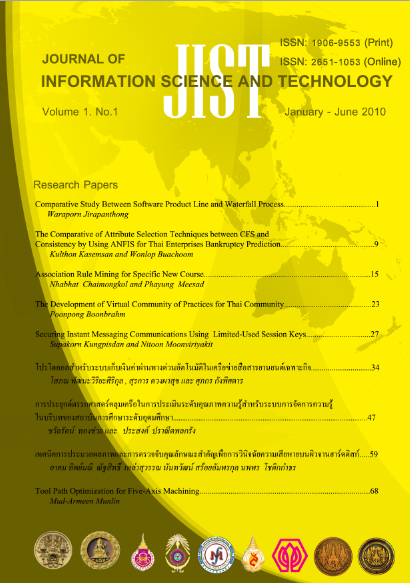Tool Path Optimization for Five-Axis Machining
Main Article Content
Abstract
- This paper presents four algorithms to optimize a tool path of a five-axis milling machine. Algorithm 1 is based on the inverse kinematics of the machine and performing continuous rotation of the rotary table. Algorithm 2 further extends the inverse kinematics and performs optimal sequencing with regard to a set of feasible rotations by using the shortest path algorithm. Algorithm 3 employs uniform angular grid to insert addition points in a machine coordinate. Algorithm 4 combines and iterates algorithm 2 and 3 by injecting the points into large loops by equi distributing them with regard to the rotation angle having the largest variation. These algorithms are most efficient in the case of the rough cut characterized by large angle variations which produce considerable errors. The efficiency of the algorithm has been verified by a virtual machining as well as by real cutting on fiveaxis machine MAHO600E at the CIM Lab of Asian Institute of Technology of Thailand.
Article Details
This work is licensed under a Creative Commons Attribution-NonCommercial-NoDerivatives 4.0 International License.
I/we certify that I/we have participated sufficiently in the intellectual content, conception and design of this work or the analysis and interpretation of the data (when applicable), as well as the writing of the manuscript, to take public responsibility for it and have agreed to have my/our name listed as a contributor. I/we believe the manuscript represents valid work. Neither this manuscript nor one with substantially similar content under my/our authorship has been published or is being considered for publication elsewhere, except as described in the covering letter. I/we certify that all the data collected during the study is presented in this manuscript and no data from the study has been or will be published separately. I/we attest that, if requested by the editors, I/we will provide the data/information or will cooperate fully in obtaining and providing the data/information on which the manuscript is based, for examination by the editors or their assignees. Financial interests, direct or indirect, that exist or may be perceived to exist for individual contributors in connection with the content of this paper have been disclosed in the cover letter. Sources of outside support of the project are named in the cover letter.
I/We hereby transfer(s), assign(s), or otherwise convey(s) all copyright ownership, including any and all rights incidental thereto, exclusively to the Journal, in the event that such work is published by the Journal. The Journal shall own the work, including 1) copyright; 2) the right to grant permission to republish the article in whole or in part, with or without fee; 3) the right to produce preprints or reprints and translate into languages other than English for sale or free distribution; and 4) the right to republish the work in a collection of articles in any other mechanical or electronic format.
We give the rights to the corresponding author to make necessary changes as per the request of the journal, do the rest of the correspondence on our behalf and he/she will act as the guarantor for the manuscript on our behalf.
All persons who have made substantial contributions to the work reported in the manuscript, but who are not contributors, are named in the Acknowledgment and have given me/us their written permission to be named. If I/we do not include an Acknowledgment that means I/we have not received substantial contributions from non-contributors and no contributor has been omitted.
References
2. Mu YH, Ngoi KA, "Dynamic error compensation of coordinate measuring machines for high-speed measurement", Int J Adv Manuf Technol, 1999, V15, pp. 810-814.
3. Aekambaram R, Raman S, "Improved toolpath generation, error measures and analysis for sculptured surface machining", Int J Prod Research, V37, N2, 1999, pp. 413-431.
4. Y. Koren, "Five-Axis Interpolators", Annals of CIPR, V.44, N1, 1995, pp.379-382.
5. Taejung Kim and Sanjay E. Sarma, “Tool path generation along directions of maximum kinematics performance; a first cut at machine-optimum paths”, Computer Aided Design 34, 2002, 453-468.
6. Chuang-Jang Chiou and Yuan-Shin Lee, “A machining potential field approach to tool path generation for multi-axis sculpture surface machining”, Computer Aided Design 34, 2002, 357-371.
7. Y.H. Jung, D.W. Lee, J.S. Kim and H.S. Mok, “NC post-processor for 5 axis milling machine of table-rotating/tilting type”, Materials Processing Technology, 130-131, 2002, 641-646.
8. Affouard, E. Duc, C. Lartigue, J.M. Langeron, and P. Bourdet, “Avoiding 5-axis singularities using tool path deformation”, International Journal of Machine Tools and Manufacture, 44(4), 2004, 415-425.
9. M. Munlin, “Tool Path Simulation Using a Virtual 5-Axis Milling Machine”, Proc. Of 2002 IEEE International Conference on Industrial Technology, Bangkok, 11-14 December 2002, pp.193-198.
10. M. A. Weiss, “Data structures and algorithm analysis in C”, Addison Wesley, 1997.


